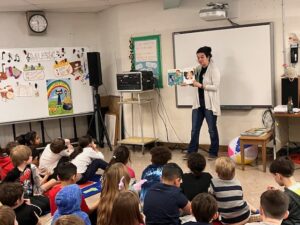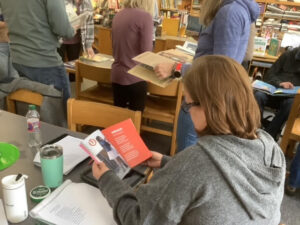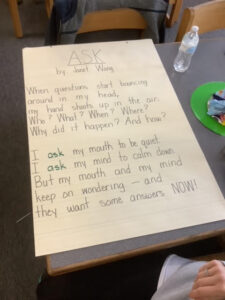When you get to combine teaching with a topic you’re passionate about– that’s the sweet spot! I just finished teaching one of my favorite courses at the community college, “Poetry in the Early Childhood Classroom.”
In this class, we dove deep into poetry: how to infuse it throughout the curriculum, how it can foster social-emotional growth, how a poem can be a window, mirror, or sliding glass door for a child.

One of the assignments of the course is “Author Study of a Poet.” This summer, my students (who all teach in early childhood) focused on Nikki Giovanni, Janet Wong, and Douglas Florian, among others. They also completed Poetry Portfolios to use in their classrooms, and made big beautiful poetry charts for shared, choral reading.

It was a creative, fun class, and their final reflections show that! Here are some of their postings:
**My view on poetry in the preschool classroom has changed dramatically. Prior to this class I would have considered myself not a fan at all. I had no idea how helpful the addition of poetry could be to introducing and elevating the curriculum in the classroom. I love the idea of adding connections to the subject at hand by utilizing poetry to enhance the topics. I am also intrigued by the humor that can be added by selecting the right poem. I love to make the kids laugh.
**I never really took the time to read poetry, but now after taking this class, it has really opened my eyes to all the different ways poetry is useful. Especially tonight’s class and listening to Mary explain how poetry can be used, like as a dipstick to see what children know, or to preview a topic. I like how poetry can also be used as an emotional rehearsal. Things can always be related to poems or vice versa.
**The same way I sometimes underestimate the power of a walk through nature is the way I can “overlook” the power of poetry in the classroom.
**I will definitely take away from this class the idea of servicing through teaching in a new light. The idea of helping a child with transitions by utilizing poetry and books as windows hit me in a whole new way. I also will take away the positive impact that poetry can have on speech development and shyness.

I had that hit of “mission accomplished” as I read these comments, and I hope they inspire any teachers who read this to add more poetry to their teaching.
Happy summer, everyone!







































